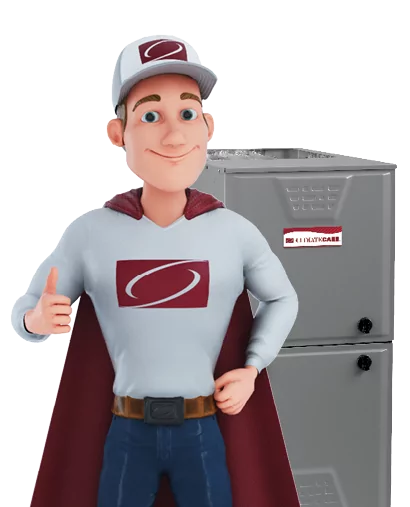
If you’re here, your furnace is probably broken 😡 And you think you need a new one. But how do you choose?
Listen, we know that choosing and changing to a new furnace system isn’t the most exciting thing in the world. Considering the expense, and the inconvenience that’s involved in many cases, it feels like a chore. Also, If you’re the kind of person that likes to do a lot of research before you buy, we hate to break the news to you that not a lot of easy-to-understand material exists out there on furnaces.
So, here is a primer that simplifies some deeply technical HVAC professional insider information. And gives you the information you need to choose the right system for your home, that can survive many Canadian winters to come.
Finding the ideal heating system for your house first (and most importantly) depends on the kind of home you have. Depending on the requirements of your home, there are several features that may be added to customize your HVAC equipment for maximum comfort. Let’s look at the different types of furnaces 👇
Furnaces Are Broadly Divided Into Three Categories: Single Stage, Two Stage & Modulating
SINGLE STAGE FURNACE: This type of furnace is the most basic and widely used variety. A single-stage furnace has only one setting. These furnaces are either on or they are off. There is no halfway point between the two. It’s also important to remember that while a single-stage furnace is on, it will operate at its highest flame setting. Single-stage heating is the most commonly used system in homes in Canada. It uses a blower on a constant speed to heat your home, not taking into account if there are more or less people in the home, or if the day is mild.
TWO-STAGE FURNACE: To provide a wider range of operation, two-stage furnaces have two settings when your furnace is on. The first is a high setting (100% – similar to a single-stage furnace) and the second is a medium setting (60%) intended to provide heating at a more moderate level. In your two-stage furnace, you will typically be able to adjust the temperature in your home, and have a greater degree of control over your home comfort. Because of this feature, it can produce longer and slower heating cycles and it is quieter, which will have an impact on your energy bills and your quality of life.
The fundamental distinction between single-stage and two-stage furnaces is flexibility. A fixed gas valve and a single-speed blower motor are components of a single-stage furnace. These furnaces are either fully operational and functioning or they are not. A two-stage furnace, however, has a gas valve and a variable-speed blower motor which has two stages of heating. As a result, the furnace can operate at a lower setting during milder weather and a higher setting during really cold weather.
MODULATING FURNACE: These furnaces use sophisticated heating technology that distributes heat more evenly throughout your home. A modulating furnace uses a flame that grows and shrinks in small increments to help you regulate the temperature of your house to your preferred level. Modulating furnaces reduce temperature variations and make it easier to deploy heating with a great deal of accuracy to provide ultimate home comfort.
Remember, in the case of the two-stage furnace, and the modulating furnace, because you are able to control many heating settings, the furnaces are more expensive than single-stage choices; but are generally more energy efficient. (more below on the costs of these 3 types)
However, don’t dismiss the single-stage heating system just yet! It can work for many.
A single-stage furnace brings a great deal of simplicity in its operation, but also comes with some drawbacks. The main drawback is that they are not as energy-efficient as their peers. Further, because the single-stage furnace is always running at full force, you’ll often find that it heats the area around the thermostat control much faster than the rest of the home. The result is that your thermostat will assume that the whole house is now heated, and switch off. This can mean that you will be left with cold and drafty spots in your home.
So, Who Is A Single-Stage Furnace Right For?
The main benefit of single-stage furnaces is that they are cheaper to purchase. Many older homes in Canada come equipped with them. So, if you have previously owned this type of furnace and have been satisfied with its ability to heat your home, you may not need a more advanced model.
If you’re on a budget, single-stage heating can be a good option. They are best for homes with simple, traditional layouts. If your home floor plan is across a single floor; and if it is not very large, this type of furnace can work very well for you.
Single-stage heating also works well in the case of spaces where the concentration of usage is in a few main areas that are near the thermostat. For example, if you have single-stage heating in your work-from-home setup, where much of your living area is concentrated in one space, you would be fine. You may find that your bedrooms get chilly but if you spend a lot of time in the living spaces and buy a stylish and comfortable comforter, maybe you’re just fine! 😁
How Much Does A New Furnace Cost?
Furnace replacement costs can range from $3,000 to $6,000. The price differs based on a variety of factors including brand, labour, warranty, and installation type, all of which have an impact on the total amount you pay. The factor that will have the most impact on the price of your furnace is the efficiency rating. Though more expensive on average, the more efficient furnaces may end up offering the best value because they can help you save money on fuel and carbon tax over time. And a top-quality furnace will last you a lot longer.
Of your options, the single-stage furnace is the least expensive type of furnace, it will cost you in the range of $3,000.
The two-stage furnace is a little more expensive, since, as we said, it can be set to run at two different levels of heating capacity: 60% and 100%. Two-stage furnaces can be 25-50% more expensive than single-stage furnaces, depending on the brand you choose.
And finally, the modulating furnace is the most expensive type. They can cost about $1,000 – 3,000 more than a single-stage furnace, due to their efficiency in both energy and production of constant heat throughout your home.
In addition to the cost of your unit, you will also need to budget for the price of the installation of your furnace. This will typically cost you about $2,000 without any discounts.
So, replacing a single-stage furnace will cost you a minimum of $5,000.

Is A Single-Stage Furnace Right For You?
Having a certified HVAC professional visit your home is the best way to save yourself a lot of heating headaches if you’re planning to replace your furnace for the cold Canadian winter months. Once one of our comfort advisors visits your home, they can address your worries about your outdated heating system and offer their expert advice on the best furnace type for your house. And if you truly are a planner, while they are there, you might want to talk to them about your cooling system as well! There are often great combination offers if you plan to upgrade more than one system in the course of a year.
Our comfort advisors will observe the right details and ask the right questions, like how long you plan to stay in your current home, how many levels your home has, whether there are any cold or hot spots in the home, when you turn your heaters on and off the most. That’s the kind of intel that will help our experts give you the best options for your budget. So find your nearest home comfort advisor here.




